Land Animals ANIMALS Underwater Animals
Biology project@jss
Friday 4 October 2013
Part C: "speciality" community
This
red flower has ants crawling all over it. Unfortunately, I do not know the name
of the flower and ant.

 This bright coloured flower was found in Jurong Lake Park. This flower has a very unique colour that makes it stand out. these flowers are what we call, hibiscus flowers. This bright coloured flower was found in Jurong Lake Park. This flower has a very unique colour that makes it stand out. these flowers are what we call, hibiscus flowers. |
This flower is the bougainvillea. It is purple in color but if you so happen to go to the jurong lake park, beware. The area surrounding this bougainvillea is covered with holes! They are deep enough to make your leg go in or even stumble on the holes. Be careful.
These
two pictures are what the squirrel ate and the squirrel itself before it ran
away. One of us were trying to take a picture of it when it suddenly dropped
its food when that person stepped on the grass. When that person stepped closer
but quietly, it remained there and continued eating. It ran away after a few
more steps in an attempt to get away.
The
red thing that you see is an insect that is floating on the water. This was
found near the edge of a small little island that is an extention from the grass
area off the walking path. Luckily, it was spotted. It was a once in a lifetime
chance to be able to see this insect for it was a first.

Thursday 3 October 2013
Part D: Impact of Man on Jurong Lake
There are many park users who utilize the facilities in Jurong Lake park, but some do not throw their litter into the bin. Instead, they they throw the litter onto the floor. When it rains, the litter will be washed into the lake and the consequences are serious. Animals would take it as food and try to consume it. This may lead to suffocation, indigestion and internal bleeding, all of which kills the animal. It also pollutes the lake making it look murky.This makes the lake less attractive just because of some selfish people.


Pictures taken from:
jssclass1-20840grp5.blogspot.com
class14group2jlp2012.blogspot.com

Pictures taken from:
jssclass1-20840grp5.blogspot.com
class14group2jlp2012.blogspot.com
Part A: Introduction of Jurong Lake Park
Jurong Lake is a 70ha freshwater lake and reservoir located in the western region of Singapore formed with the damming of Sungei Jurong further downstream. The lake serves as a reservoir contributing to the water supplyof the country. It lies next to the Lakeside MRT Station, which derived its name from this geographical feature. The lake is surrounded by parkland, which serves as a recreational ground for nearby residents in Jurong East and Jurong West New Towns.
A landscaped sanctuary called Jurong Lake Park was built around the perimeter of the lake and work was completed in January 2006. Also, a 2.8 kilometre water promenade along Jurong Lake Park would allow residents to participate in water sports.
As is the case for most other reservoirs in Singapore, swimming is currently illegal in the lake, although this may change in line with the Singapore government's liberalisation of the use of bodies of water in the republic. Fishing is now allowed in some designated spots around the lake where only artificial baits can be used for fishing.
There are several tourist attractions located near or even within the Lake, including a Chinese Garden and a Japanese Garden, which are located on their respective islands within the lake, as well as the nearby Tang Dynasty Village, which has since closed down.
The Science Centre, Singapore, a family-oriented attraction in Jurong East, is located in the area, together with Jurong Country Club, which includes a 18-hole par-72 golf course and driving range.

Image: Map Of Jurong Lake Park
On 4 April 2008, the National Development Minister Mah Bow Tan announced a plan to develop the Jurong into a commercial hub outside the Central Business District. The new Jurong Lake District will offer a potential development area of 360 hectares, roughly the size of Marina Bay. The Urban Redevelopment Authority said that some 750,000m2 of land will be set aside at Jurong Gateway, expected to attract billions of dollars in development, for offices, hotels, food and beverage and entertainment uses. However, analysts say that the short 10–15 years time frame may be a little tight, due to the amount of projects in progress and a dampened global economic climate.
The Urban Redevelopment Authority announces a masterplan on 4 April 2008 to transform the area around Jurong Lake to a unique lakeside destination for business and leisure in the next 10 to 15 years.
A new district will be created, named, Jurong Lake District which consists of two precincts, Jurong Gateway and Lakeside. These refer to the areas around the Jurong East MRT Station and Jurong Lake in the west region of Singapore. Jurong Lake and the area around it, known as Lakeside, is the other area in the Jurong Lake District.
New developments around Jurong Lake include:
- A public park will be developed next to Lakeside MRT Station
- New Science Centre will be built next to Chinese Garden MRT Station
- Lakeside village
- Enhanced Chinese Garden and Japanese Garden
Information taken from :
Wikipedia ( http://en.wikipedia.org/wiki/Jurong_Lake)
Picture taken from :
Part E: Conservation efforts at Jurong Lake Park
Part E:
Conservation Efforts at Jurong Lake Park
 The government and authorities have made efforts to conserve Jurong Lake Park. There are signs around Jurong Lake Park to tell park-users not to:
The government and authorities have made efforts to conserve Jurong Lake Park. There are signs around Jurong Lake Park to tell park-users not to:- swim in the lake
- use live baits to fish
- litter
 The government and authorities also put rubbish bins and recycle bins around Jurong Lake Park.
The government and authorities also put rubbish bins and recycle bins around Jurong Lake Park. However, these efforts are not very effective as litter such as plastic bottles and papers can still be seen in the park. I think it is because that people need to walk quite a long distance to find another rubbish bin if they missed one earlier on. Hence, they just throw the litter into the lake or on the ground as they are too lazy to walk long distances to find the rubbish bin.

I would suggest the authorities to place more rubbish bins in the park so that it will be more convenient for people to throw their rubbish and thus, the amount of litter will be reduced.
Yes, the authorities is doing their part to safeguard the natural environment. They hire cleaners to clear up rubbish on the ground. They also put up noticeboards and signs around the natural environment to remind tourists and people to throw litter into the rubbish bins, not on the ground.
Although there is still rubbish in the natural environment, the amount of rubbish on the ground is little. Therefore, I believe that the authorities is doing their part.
Everyone should do their part to conserve the natural environment. Here are some of the things we can do:
- save trees by recycling newspapers and magazines
- reduce greenhouse gases by walking or using bicycles instead of taking cars
- bring our own bags, such as paper bags, when buying things to reduce the usage of plastic bags, which are non-biodegradable


 Natural environment provides homes for the world's plants and animals. It supply plants and animals with everything they need, such as food, shelter and protection. In addition, natural environment provides the oxygen we breathe, the water we drink, the food we eat and the materials we need for buildings.
Natural environment provides homes for the world's plants and animals. It supply plants and animals with everything they need, such as food, shelter and protection. In addition, natural environment provides the oxygen we breathe, the water we drink, the food we eat and the materials we need for buildings. From the information above, we can know how important natural environment is. Thus, we should make an effort to conserve the natural environment.
From the information above, we can know how important natural environment is. Thus, we should make an effort to conserve the natural environment.Credits: Pictures
- http://class13group4jlp2012.blogspot.sg/
- http://impactofmanonjlp.blogspot.sg/2013/07/impact-of-man-on-jurong-lake-park.html#!/2013/07/impact-of-man-on-jurong-lake-park.html
- http://class11group9jlp2011.blogspot.sg/2011_07_01_archive.html
- http://www.somersetwaste.gov.uk/sites/
- http://www.kinnelonconserves.net/Paper-Bags.html
- http://www.fanpop.com/clubs/animals/images/27943051/title/awesomw-animals-wallpaper
Subscribe to:
Posts (Atom)











